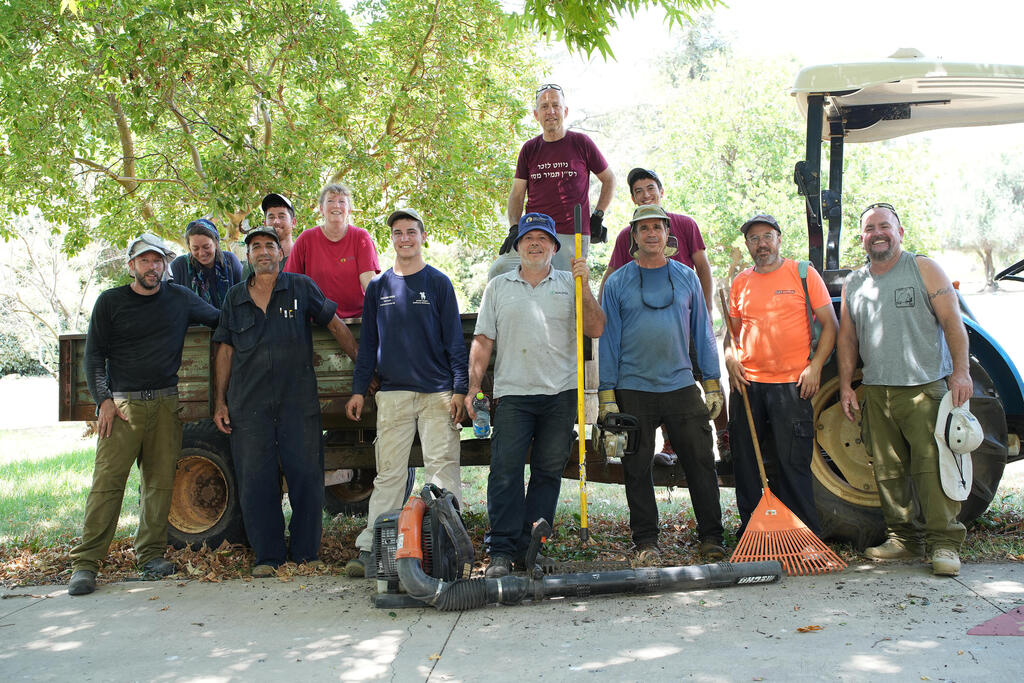Getting your Trinity Audio player ready...
Last week, volunteers from the Sde Eliyahu religious kibbutz arrived at Kibbutz Snir, whose residents were displaced more than nine months ago. When they entered the gates of the kibbutz, they were amazed to see the rusty facilities in the amusement parks and the paths of the roads that disappeared under the vegetation that grew wild. For two days, from morning to evening, they worked to prepare the kibbutz for the residents who would choose to return home.
Rockets near Kibbutz Snir
(Video: Omer Shita)
Dael Levy, one of the volunteers, came with his family. "We came out of mutual and national solidarity," he shared. "Although it's quiet in our area in Emek Hamaayanot (Valley of the Springs), it's hard for us to see what’s happening here and not help. We want to give a good feeling to those who want to return. In the end, settlement, the plow and the rake set the boundary."
Lior Shelef, a member of Kibbutz Snir’s auxiliary security squad, couldn’t hide his excitement: "Our community was very neglected. We cleaned all the playgrounds and greased the swing cables. In Sde Eliyahu’s metal workshop, they prepared special iron shelters for our kibbutz guard posts to protect against kamikaze drones."
Since October 7, thousands of Upper Galilee residents have been scattered among hotels, rented apartments and relatives' homes. The civil, social and economic crisis they faced has only grown, with hardships intensifying against the backdrop of the government's inability to give them hope of safely returning home. After months of giving the government credit to act without setting a target date, many fear they’ve been forgotten and believe the government has become accustomed to the fact that over 40 communities in Israel have been evacuated due to Hezbollah threats. Now, they seek to lead, not be led, and announce the establishment of a movement: "Home. Returning to the Galilee."
The founding core of this initiative comprises Upper Galilee residents, with support from the Upper Galilee Regional Council, Hashomer Hahadash organization, the Fourth Quarter movement, and many organizations and volunteers from across the country. They have already begun preparing the ground to accelerate the rehabilitation of the settlements. They are recruiting educators and youth instructors willing to move north and operate full education systems starting September 1, and hundreds of volunteers are performing gardening and renovation work in the abandoned kibbutzim.
Erez Bergman recently returned to his home in Kibbutz Snir with his wife Maya and their three children. Despite the recent barrages from Lebanon that also affected non-evacuated settlements and led to several deaths, he believes the journey home must not stop. "This is modern Zionism," he said. "If we come back here, it will force the state to provide answers and end the status quo of insecurity that has developed here. Of the approximately 700 residents who lived in Snir, about 200 have returned. In Kibbutz HaGoshrim, 200 out of 1,400 have returned, and in Kibbutz Dan, 120 out of 800. There are also a few residents who have returned to Dafna and Ma'ayan Baruch."
Bergman did not hide the heavy costs of the decision to return. "I manage risks daily for the physical and mental health of my children. Last Thursday, we thought we were packing our bags and returning to Beit Alfa. These are days when you don’t understand what you’re doing here. One day I took Mika, 9, to the playground, and there were five rocket alert sirens in a row. She saw a drone explode outside the kibbutz and broke down. We believe we need to be here, but it’s very hard sometimes, in a dead community with no grocery store, clinic or other basic services."
Aya and Erez Yaakov recently returned to Kibbutz Ma'ayan Baruch with their children Asaf, 10, and Itamar, 8. "We choose every time to stay here, and if things don’t improve or the situation changes and the army starts acting - we’ll get up and leave," said Aya. The children study in non-evacuated settlements and return home every day, staying close to the protected area. Erez explained: "The children know we’re a kind of pioneers. It’s our mission and responsibility to create the movement."
When asked if they fear their return will encourage the government to revert to the previous threatening reality, they replied: "Staying in hotels and evacuation centers also creates a bad reality. We believe that not being here legitimizes ignoring the situation."
The events of October 7 awakened the young people of the area who dreamed of a "food-tech" revolution, academia and guesthouses and confronted them for the first time with threats from across the border by the murderous terrorist organization Hezbollah - which many hoped was indeed deterred as repeatedly stated by the defense establishment and the government.
"In this harsh reality, we have an opportunity to present the state with a new set of priorities and write a new story for the Galilee together. We have nothing to wait for; it depends only on us. Our goal is to bring the scattered communities closer, and strengthen the communities still here and on the front lines in the non-evacuated settlements," Nissan Ze'evi, a member of the evacuated Kibbutz Kfar Giladi, said.
Tom Lahad from the non-evacuated Kibbutz of Ayelet HaShahar, which is under attack by drones and rockets, called the situation a historic opportunity. "We must mark the direction and stop waiting for someone else, to see the situation as a historic opportunity to re-establish the Galilee and remind ourselves and our children of the importance of this region," he said.
However, attempts to encourage a return home come with the understanding that most residents will fear returning to an area in a war with no end in sight. On Monday, the Ministry of Settlement and the Settlement Division launched a special plan called "Until the North Blooms Again," aimed at strengthening the resilience of northern communities. For this, 20 million shekels (approximately $5.3 million) were allocated.
"We will build community resilience with the understanding that if there is no community, there will also be no people," explained Settlement Minister Orit Stroock at the launch event held at Kibbutz Ayelet HaShahar.






